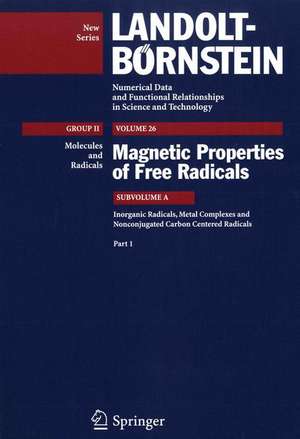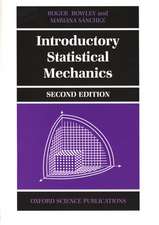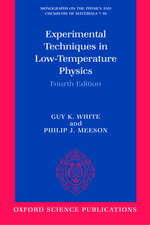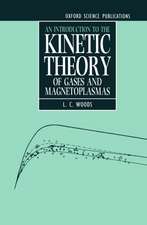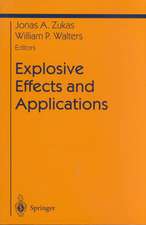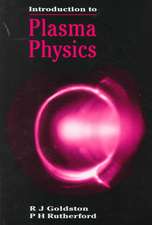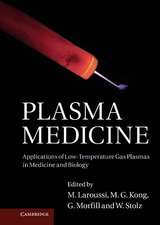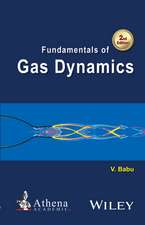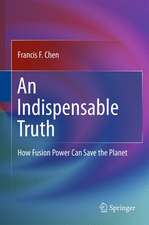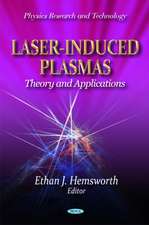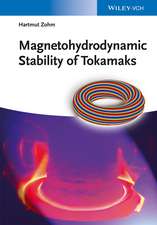Inorganic Radicals, Metal Complexes and Nonconjugated Carbon Centered Radicals: Landolt-Börnstein: Numerical Data and Functional Relationships in Science and Technology - New Series, cartea 26A1
Autor A.L.J. Beckwith, R.F.C. Claridge, J.A. Howarden Limba Engleză Hardback – 27 iun 2007
Din seria Landolt-Börnstein: Numerical Data and Functional Relationships in Science and Technology - New Series
- 27%
 Preț: 3008.38 lei
Preț: 3008.38 lei - 27%
 Preț: 25567.07 lei
Preț: 25567.07 lei - 27%
 Preț: 15494.67 lei
Preț: 15494.67 lei - 27%
 Preț: 56333.48 lei
Preț: 56333.48 lei - 27%
 Preț: 23758.38 lei
Preț: 23758.38 lei - 27%
 Preț: 10336.10 lei
Preț: 10336.10 lei - 27%
 Preț: 3015.27 lei
Preț: 3015.27 lei - 27%
 Preț: 11647.64 lei
Preț: 11647.64 lei - 27%
 Preț: 3004.32 lei
Preț: 3004.32 lei - 27%
 Preț: 3007.10 lei
Preț: 3007.10 lei - 27%
 Preț: 24683.06 lei
Preț: 24683.06 lei - 27%
 Preț: 2991.64 lei
Preț: 2991.64 lei - 27%
 Preț: 10722.57 lei
Preț: 10722.57 lei - 27%
 Preț: 15591.61 lei
Preț: 15591.61 lei - 27%
 Preț: 3012.74 lei
Preț: 3012.74 lei - 27%
 Preț: 22634.50 lei
Preț: 22634.50 lei - 27%
 Preț: 20419.85 lei
Preț: 20419.85 lei - 27%
 Preț: 52699.38 lei
Preț: 52699.38 lei - 27%
 Preț: 3019.05 lei
Preț: 3019.05 lei - 27%
 Preț: 3011.31 lei
Preț: 3011.31 lei - 27%
 Preț: 3005.86 lei
Preț: 3005.86 lei - 27%
 Preț: 3007.82 lei
Preț: 3007.82 lei - 27%
 Preț: 45426.29 lei
Preț: 45426.29 lei - 27%
 Preț: 2991.64 lei
Preț: 2991.64 lei - 27%
 Preț: 2990.53 lei
Preț: 2990.53 lei - 27%
 Preț: 3014.14 lei
Preț: 3014.14 lei - 27%
 Preț: 35531.62 lei
Preț: 35531.62 lei - 27%
 Preț: 2983.77 lei
Preț: 2983.77 lei - 27%
 Preț: 63610.18 lei
Preț: 63610.18 lei - 27%
 Preț: 41983.08 lei
Preț: 41983.08 lei - 27%
 Preț: 60847.07 lei
Preț: 60847.07 lei - 27%
 Preț: 3004.16 lei
Preț: 3004.16 lei - 27%
 Preț: 2999.39 lei
Preț: 2999.39 lei - 27%
 Preț: 26904.44 lei
Preț: 26904.44 lei - 27%
 Preț: 24170.23 lei
Preț: 24170.23 lei - 27%
 Preț: 26762.63 lei
Preț: 26762.63 lei - 27%
 Preț: 10163.01 lei
Preț: 10163.01 lei - 27%
 Preț: 3002.88 lei
Preț: 3002.88 lei - 27%
 Preț: 28827.03 lei
Preț: 28827.03 lei - 27%
 Preț: 27718.06 lei
Preț: 27718.06 lei - 27%
 Preț: 24696.14 lei
Preț: 24696.14 lei - 27%
 Preț: 54520.40 lei
Preț: 54520.40 lei - 27%
 Preț: 3002.20 lei
Preț: 3002.20 lei - 27%
 Preț: 45426.84 lei
Preț: 45426.84 lei - 27%
 Preț: 13981.76 lei
Preț: 13981.76 lei - 27%
 Preț: 4736.37 lei
Preț: 4736.37 lei - 27%
 Preț: 8640.35 lei
Preț: 8640.35 lei - 27%
 Preț: 15025.01 lei
Preț: 15025.01 lei - 27%
 Preț: 2992.36 lei
Preț: 2992.36 lei - 27%
 Preț: 6465.31 lei
Preț: 6465.31 lei
Preț: 3007.82 lei
Preț vechi: 4120.29 lei
-27% Nou
Puncte Express: 4512
Preț estimativ în valută:
575.55€ • 602.44$ • 479.04£
575.55€ • 602.44$ • 479.04£
Carte tipărită la comandă
Livrare economică 31 martie-14 aprilie
Preluare comenzi: 021 569.72.76
Specificații
ISBN-13: 9783540484653
ISBN-10: 3540484655
Pagini: 454
Ilustrații: XII, 434 p.
Dimensiuni: 178 x 254 x 25 mm
Greutate: 1.34 kg
Ediția:2007
Editura: Springer Berlin, Heidelberg
Colecția Springer
Seriile Landolt-Börnstein: Numerical Data and Functional Relationships in Science and Technology - New Series, Molecules and Radicals
Locul publicării:Berlin, Heidelberg, Germany
ISBN-10: 3540484655
Pagini: 454
Ilustrații: XII, 434 p.
Dimensiuni: 178 x 254 x 25 mm
Greutate: 1.34 kg
Ediția:2007
Editura: Springer Berlin, Heidelberg
Colecția Springer
Seriile Landolt-Börnstein: Numerical Data and Functional Relationships in Science and Technology - New Series, Molecules and Radicals
Locul publicării:Berlin, Heidelberg, Germany
Public țintă
ResearchCuprins
I General introduction.- III General symbols and abbreviations.- 1.1 Introduction.- 1.2 Trapped electron.- 1.3 Hydrogen-centered radicals.- 1.4 Lithium-centered radicals.- 1.5 Boron-centered radicals.- 1.6 Carbon-centered radicals.- 1.7 Nitrogen-centered radicals.- 1.8 Oxygen-centered radicals.- 1.9 Fluorine-centered radicals.- 1.10 Sodium-centered radicals.- 1.11 Magnesium-centered radicals.- 1.12 Aluminum-centered radicals.- 1.13 Silicon-centered radicals.- 1.14 Phosphorus-centered radicals.- 1.15 Sulfur-centered radicals.- 1.16 Chlorine-centered radicals.- 1.17 Potassium-centered radicals.- 1.18 Scandium-centered radicals.- 1.19 Titanium-centered radicals.- 1.20 Vanadium-centered radicals.- 1.21 Chromium-centered radicals.- 1.22 Manganese-centered radicals.- 1.23 Cobalt-centered radicals.- 1.24 Nickel-centered radicals.- 1.25 Copper-centered radicals.- 1.26 Zinc-centered radicals.- 1.27 Gallium-centered radicals.- 1.28 Germanium-centered radicals.- 1.29 Arsenic-centered radicals.- 1.30 Selenium-centered radicals.- 1.31 Bromine-centered radicals.- 1.32 Yttrium-centered radicals.- 1.33 Niobium-centered radicals.- 1.34 Molybdenum-centered radicals.- 1.35 Ruthenium-centered radicals.- 1.36 Palladium-centered radicals.- 1.37 Silver-centered radicals.- 1.38 Cadmium-centered radicals.- 1.39 Indium-centered radicals.- 1.40 Tin-centered radicals.- 1.41 Tellurium-centered radicals.- 1.42 Iodine-centered radicals.- 1.43 Lanthanum-centered radicals.- 1.44 Tantalum-centered radicals.- 1.45 Osmium-centered radicals.- 1.46 Iridium-centered radicals.- 1.47 Platinum-centered radicals.- 1.48 Gold-centered radicals.- 1.49 Mercury-centered radicals.- 2.1 Introduction.- 2.2 Lithium-centered radicals.- 2.3 Boron-centered radicals.- 2.4 Sodium-centered radicals.- 2.5 Aluminum-centered radicals.- 2.6 Silicon-centered radicals.- 2.7 Phosphorus-centered radicals.- 2.8 Potassium-centered radicals.- 2.9 Scandium-centered radicals.- 2.10 Titanium-centered radicals.- 2.11 Vanadium-centered radicals.- 2.12 Chromium-centered radicals.- 2.13 Manganese-centered radicals.- 2.14 Cobalt-centered radicals.- 2.15 Copper-centered radicals.- 2.16 Zinc-centered radicals.- 2.17 Gallium-centered radicals.- 2.18 Rubidium-centered radicals.- 2.19 Yttrium-centered radicals.- 2.20 Zirconium-centered radicals.- 2.21 Niobium-centered radicals.- 2.22 Molybdenum-centered radicals.- 2.23 Rhodium-centered radicals.- 2.24 Silver-centered radicals.- 2.25 Cadmium-centered radicals.- 2.26 Cesium-centered radicals.- 2.27 Lanthanum-centered radicals.- 2.28 Tantalum-centered radicals.- 2.29 Tungsten-centered radicals.- 2.30 Osmium-centered radicals.- 2.31 Iridium-centered radicals.- 2.32 Gold-centered radicals.- 2.33 Mercury-centered radicals.- 4.1 Introduction.- 4.2.1 Primary alkyl radicals, type R-CH2-CH2•.- 4.2.2 Primary alkyl radicals, type R2CH–CH2•.- 4.2.3 Primary alkyl radicals, type R3C–CH2•.- 4.2.4 Primary alkyl radicals, type R–CH2•.- 4.3.1 Secondary alkyl radicals, type R1–CH2–?H–CH2–CH2–R2.-4.3.2 Secondary alkyl radicals, type R1–?H–CH2–CH2–R2.- 4.3.3 Secondary alkyl radicals, type R1–CH2–?H–CH2–R2.- 4.3.4 Secondary alkyl radicals, type R1–CH2–?H–CHR2.- 4.3.5 Secondary alkyl radicals, type R1–?H–CH2–R2.- 4.3.6 Secondary alkyl radicals, type R1–?H–CHR2 2.- 4.3.7 Secondary alkyl radicals, type R1–?H–CR2 3.- 4.3.8 Secondary alkyl radicals, type R1–?H–R2.- 4.4.1 R1, R2 and R3: Leading atom is carbon.- 4.4.2 R1, R2 and R3: Leading atom other than carbon.- 4.4.3 R1 and R2: Alkyl or substituted alkyl; R3: Leading atom other than carbon.- 4.4.4 R1 and R2: Leading atom other than carbon; R3: Leading atom carbon.- 4.4.5 R1: Alkyl or substituted alkyl; R2: Carbon centered functional group; R3: Leading atom other than carbon.- 4.5.1.1 Alkyl radicals from 3-membered rings.- 4.5.1.2 Alkyl radicals from 4-membered rings.- 4.5.1.3 Alkyl radicals from 5-membered rings.- 4.5.1.4 Alkyl radicals from 6-membered rings.- 4.5.1.5 Alkyl radicals from 7- and higher membered rings.- 4.5.2.1 Radicals from fused rings and spiro compounds.- 4.5.2.2 Radicals from bridged rings.- 4.6.1 Acyl and related radicals.- 4.6.2 Aryl radicals.- 4.6.3 Vinyl radicals.
Caracteristici
Standard reference book with selected and easily retrievable data from the fields of physics and chemistry collected by acknowledged international scientists Also available online in www.springerLink.com http://www.springerlink.com/book-series/?sw=landolt http://www.landolt-boernstein.com Includes supplementary material: sn.pub/extras
